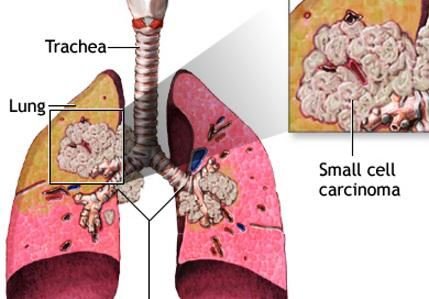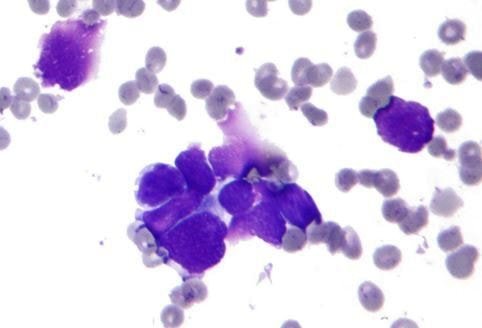Oat Cell Carcinoma Definition
When the tumor of the lungs begins to undergo an uncontrolled growth of cells in lung tissues, the condition is referred to as a lung cancer. Lung cancer has been one of the many cause of deaths in both genders and any part of the lungs can be affected.
Types
Oat cell cancer
This is also known with its other name small-cell carcinoma. It is highly malignant and could spread quickly to other parts of the body as compared to non-small cell cancer.

Oat cell carcinoma is less common in comparison to non-cell lung cancer and almost all cases of the condition is linked with smoking. Small cell carcinoma is estimated to be accountable for about 10% up to 15% of all lung cancer cases. The condition is subdivided into two parts and these are:
- Limited – the early phase
- Extensive – the late phase
Non-small cell cancer
This accounts for about the 85% up to 90% of lung cancer cases. It has three main cell subtypes based on the differences in:
- Size
- Shape
- Chemical make-up
Symptoms of Oat Cell Carcinoma
The symptoms of oat cell carcinoma or other lung cancers can be alike to the symptoms of some other conditions. In most cases, there are no symptoms present until it had spread widely in various areas. Metastasis which is the spreading of cancer from one organ to another frequently occurs, and is accompanied with different signs and symptoms depending on the region of metastasis.
It is common to the liver, bones, brain, and kidney in oat cell carcinoma. Breathing problem is a typical symptom in the last stage due to the blockage of the air passages caused by tumors and reduced flow of oxygen into the lungs.
Clinical symptoms may include:
- Pneumonia
- Hoarseness
- Headache
- Chest pain that is occasionally worsened by deep breathing
- Blood-tinged mucus coming from the lungs
- Difficulty of breathing
- Facial inflammation
- Relentless coughing
- Fatigue
- Back pain
- Swallowing problems
- Nausea and vomiting
Causes of Oat Cell Carcinoma
Tobacco smoking is often the cause of oat cell carcinoma and non-small cell cancer.
Risk factors which may lead to Oat Cell Carcinoma:
- Secondhand tobacco smoke is still considered as a risk factor and is not an exemption for lung cancer.
- Those individuals who often mine uranium are also prone to the disease and the risk is increased among smokers.
- A person’s exposure to radon which is a gas that forms from the decomposition of uranium has been accounted to cause the condition.
- The risk of developing the condition increases 9 times for those who are exposed to asbestos.
- A mixture of tobacco smoking and asbestos exposure increases the possibility by 50%.
Diagnosis
Oat cell carcinoma spreads so fast in other parts of the body that by the time the person is diagnosed, it might already be in the last stages of the condition.
Physical examination is done completely by an attending physician to assess for the presenting symptoms before taking the patient’s medical history. Depending on the symptoms, smoking history may be asked as well.
Diagnostic tests to precisely confirm the condition include:
- Microscopic investigation of sputum
- Biopsy of the lungs

- X-ray of the chest
- Bone scan
- Imaging tests such as CT scan, MRI, and PET scan
Staging
- Limited stage – The disease is limited to one side of the chest in the limited stage and lymph nodes are possibly affected.
- Extensive stage – In the extensive stage, the condition had already scattered to the other part of the chest or other body parts. When the cancer cells are located in the area of the lungs surrounded by fluid, it is an extensive stage condition which is not curable anymore.
Treatment
Fast treatments results to better outcomes. For people in the extensive stage of cancer, treatment goal is only to ease the symptoms and not eliminate them.
- Surgery is not quite helpful, but is sometimes done when the cancer cells had not yet spread to other body parts.
- Chemotherapy is the most effective for this condition, which is either taken orally or intravenously.
- Radiation therapy is another option that uses X-rays to get rid of cancer cells.
Prognosis
Unfortunately, oat cell carcinoma has a low survival rate since this disease is aggressive. For limited stage, an estimation of 45% survives with a span of 2 years and 20% survives for 5 years. For extensive stage, there is about 4.6% chance that a person survives for 2 years.
Prognosis is poor with about 6% of individuals who survive for as long as 6 years. When left untreated, survival is 2 to 4 months. If there are treatments, extensive last stage patients live for about 6 to 12 months.
References:
- http://www.emedicinehealth.com/small-cell_lung_cancer/article_em.htm#small-cell_lung_cancer_overview
- Listen Small-Cell Lung Cancer – Symptoms, Causes, Treatment at http://www.webmd.com/lung-cancer/guide/small-cell-lung-cancer
- http://www.healthline.com/health/lung-cancer-small-cell#Treatment5
- Pelosi G, Sonzogni A, Galetta D, et al. (April 2011). “Combined small-cell carcinoma of the lung with quadripartite differentiation of epithelial, neuroendocrine, skeletal muscle, and myofibroblastic type”. Virchows Arch. 458 (4): 497–503.
- Nasu K, Hirakawa T, Okamoto M, et al. (2011). “Advanced small cell carcinoma of the uterine cervix treated by neoadjuvant chemotherapy with irinotecan and cisplatin followed by radical surgery”. Rare Tumors 3 (1): e6.
- Cotran, Ramzi S.; Kumar, Vinay; Fausto, Nelson; Nelso Fausto; Robbins, Stanley L.; Abbas, Abul K. (2005). Robbins and Cotran pathologic basis of disease. St. Louis, Mo: Elsevier Saunders. p. 759.
Similar Posts:
- Acinic Cell Carcinoma
- Urothelial Carcinoma
- CEA Tumor Marker
- Leiomyosarcoma – Survival Rate, Symptoms, Prognosis, Treatment
- Choriocarcinoma – Symptoms, Prognosis, Treatment, Diagnosis
- Fallopian Tube Cancer – Symptoms, Prognosis, Survival Rate, Treatment
- Pancoast Tumor – Symptoms, Treatment, Survival Rate and Prognosis






Leave a Reply